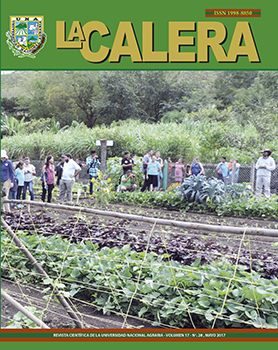Population dynamic of insect pest associated to plantain (Musa paradisiaca L.) in Rivas, Nicaragua
DOI:
https://doi.org/10.5377/calera.v17i28.6363Keywords:
plantain, insect, pest, population dinamicsAbstract
Plantain cultivation is a high yield commodity with an acceptable and production rates in Nicaragua, it represents an alternative product of great importance in the department of Rivas. Crop security is provided for small, medium and large producers, but, it has been threatened by a group of pests and diseases that affect plant and fruit. With the aim of contributing to scientifi c knowledge on major insect pests associated to cultivation of plantain (Musa paradisiaca. L), this study was conducted in the period from January to September 2014 in six plantain farms of the department of Rivas. For this study sampling of weevil insect was done by using plantain corms as discs. To sample insects in plantain leaves, the bottom canopy leaves of 25 plants per farm were sampled. All insects found in the study were identifi ed in the laboratory of entomology at the National Agrarian University. The identified insects were, Cosmopolites sordidus, Methamacius hemipterus, Rhinchosporum Palmarum and Dysmicoccus Grassi. The months of May through September were the period where increased presence of these insects was found, compared to the summer months of January to April where populations found of these insects was lower.
Downloads
Metrics
References
APLARI (Asociación de Plataneros de Rivas, NI). 2013. Conglomerado del plátano en Nicaragua. NI. 715 p.
Barrios Díaz, B; Alatorre Rosas, R; Calyecac Cortero, HG; Bautista Martinez, N. 2004. Identificación y fluctuación poblacional de las plagas de la col (Brassica oleracea var. Capitata) y sus enemigos naturales en Acatzingo, Puebla, MX. Agrociencia 38:339-248.
Guerrero, M. 2010. Guía técnica del cultivo del Plátano. Programa MAG-CENTA-Frutales. centro nacional de tecnologia agropecuaria y forestal “Enrique Alvarez Córdova”. 21 p.
Jiménez Martínez, E. Rodriguez Flores, O. 2014. Universidad Nacional Agraria. Insectos: Plagas de cultivos en Nicaragua. Managua, NI. 218 p.
Lacayo, R. Mayorga, J. 2014. Abundancia, riqueza y diversidad insectil asociada al cultivo de Marango (Moringa oleifera L.). Ingeniero agrónomo. Managua, NI. Universidad Nacional Agraria. 56 p.
MIFIC (Ministerio de Fomento, Industria y Comercio, NI). 2009. Ficha del Plátano. Managua Nicaragua, 22 p.
Núnes, C. Dávila, ML. 2004. Taxonomía de las principales familias y subfamilias de insectos de interés agrícolas en Nicaragua. UCAPSE (Universidad Católica Agropecuaria del Trópico Seco Estelí) Nicaragua. 164 p.
Rosales, FE; Álvarez, JM; Vargas, A. 2003. Guía práctica para la producción de plátano con altas densidades, Experiencias de América Latina y el Caribe. 25 p.
Rugama Lovo, IM. López Vílchez, ME. 2011. Identificación y descripción de los principales insectos rastreros asociados al cultivo del marañón (Anacardium occidentalis L.) orgánico y convencional, en león, Nicaragua. Ingeniero agrónomo. Managua, NI. Universidad Nacional Agraria. 94 p.
Sáenz, M; De La Llana, A. 1990. Entomología sistemática. UNA (Universidad Nacional Agraria). Managua, NI. 225 p.
SAS Institute. 2003. University of Nebraska. Cary, NC, USA.V.91
Urías López, MA; Salazar García, S; Johandsen Naime, R. 2007. Identificación y fluctuación poblacional de especies de trips (Thysanoptera) en aguacate Hass en Nayarit, México. MX. Revista Chapingo Serie Horticultura 13(1): 49-54.
Vargas-Carrillo, E. 2011. Guía para la identificación y manejo integrado de plagas en piña. San José, CR. En línea. s.e. REPCAR, PROAGROIN. Consultado 19 sep. 2013. Disponible en:












